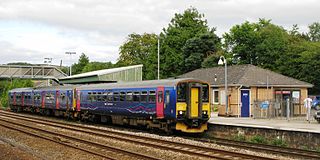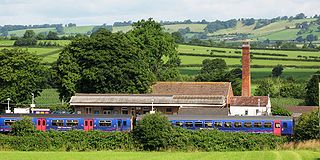
Didcot Parkway is a railway station serving the town of Didcot in Oxfordshire, England. The station was opened as Didcot on 12 June 1844 and renamed Didcot Parkway on 29 July 1985 by British Rail to reflect its role as a park and ride railhead. It is 53 miles 10 chains down the line from London Paddington and is situated between Cholsey to the east and Swindon to the west.

Yeovil Pen Mill railway station is one of two stations serving the town of Yeovil, Somerset, England. The station is situated just under a mile to the east of the town centre. The station is located 59.5 miles (96 km) south of Bristol Temple Meads, on the Heart of Wessex Line. The station is managed by Great Western Railway, with trains being operated by them and by South Western Railway.

Feniton railway station serves the village of Feniton in Devon, England. It was opened by the London and South Western Railway (LSWR) in 1860 but is now operated by South Western Railway which provides services on the West of England Main Line. It is 159 miles 24 chains (256.4 km) down the line from London Waterloo.

Totnes railway station serves the towns of Totnes and Dartington in Devon, England. It was opened by the South Devon Railway Company in 1847. Situated on the Exeter to Plymouth Line, it is 222 miles 66 chains measured from the zero point at London Paddington via Box.

Honiton railway station serves the town of Honiton in east Devon, England. It is operated by South Western Railway and is 154 miles 60 chains (249.0 km) down the line from London Waterloo, on the West of England Line.

Axminster railway station serves the town of Axminster in Devon, England. It is operated by South Western Railway and is situated on the West of England Main Line. It is 144 miles 41 chains (232.6 km) down the line from London Waterloo.

Crediton railway station is a railway station serving the town of Crediton in Devon, England. It is 7 miles 76 chains (12.8 km) from Exeter Central at milepost 179.25 from London Waterloo.

Castle Cary railway station is on the Reading to Taunton line 115.25 miles (185.48 km) south west of London Paddington and the Bristol to Weymouth line 47.75 miles (77 km) south of Bristol Temple Meads. The two routes share tracks between Westbury and Castle Cary stations and are both operated by Great Western Railway, which also manages the station. The station is 1 mile (1.6 km) north of the town of Castle Cary and 5 miles (8 km) south of Shepton Mallet in a largely rural area of Somerset, England.

Bruton railway station serves a largely rural area in the county of Somerset in England. The station is situated in the market town of Bruton. The station is on the Bristol to Weymouth line some 32.75 miles (53 km) south of Bath Spa. Trains on the Reading to Taunton line pass through the station but do not normally stop. Services are operated by Great Western Railway and South Western Railway.

The Bristol and Exeter Railway (B&ER) was an English railway company formed to connect Bristol and Exeter. It was built on the broad gauge and its engineer was Isambard Kingdom Brunel. It opened in stages between 1841 and 1844. It was allied with the Great Western Railway (GWR), which built its main line between London and Bristol, and in time formed part of a through route between London and Cornwall.

The South Devon and Tavistock Railway linked Plymouth with Tavistock in Devon; it opened in 1859. It was extended by the Launceston and South Devon Railway to Launceston, in Cornwall in 1865. It was a broad gauge line but from 1876 also carried the standard gauge trains of the London and South Western Railway between Lydford and Plymouth: a third rail was provided, making a mixed gauge. In 1892 the whole line was converted to standard gauge only.

Frome railway station serves a largely rural area of the county of Somerset in England, and is situated in the town of Frome. The station is located on a 1.5 miles (2.4 km) long branch line which loops off the main line railway, which carries services on both the Reading to Taunton line and Bristol to Weymouth route. Most of the trains which take the loop line in order to serve Frome station are on the Bristol to Weymouth route, and most trains on the Reading to Taunton line by-pass the station on the main line. The station is 22.25 miles (36 km) south of Bath Spa on the Bristol to Weymouth line, it is owned by Network Rail and is operated by Great Western Railway.
The Wilts, Somerset and Weymouth Railway (WS&WR) was an early railway company in south-western England. It obtained Parliamentary powers in 1845 to build a railway from near Chippenham in Wiltshire, southward to Salisbury and Weymouth in Dorset. It opened the first part of the network but found it impossible to raise further money and sold its line to the Great Western Railway (GWR) in 1850.
There are 22 disused railway stations on the Bristol to Exeter line between Bristol Temple Meads and Exeter St Davids. The line was completed in 1844 at which time the temporary terminus at Beambridge was closed. The most recent closure was Tiverton Junction which was replaced by a new station} on a different site in 1986. 12 of the disused stations have structures that can still be seen from passing trains.

The Exeter to Plymouth railway of the London and South Western Railway (LSWR) was the westernmost part of a route competing with that of the Great Western Railway (GWR) and its 'associated companies' from London and Exeter to Plymouth in Devon, England. Whereas the GWR route from Exeter followed the coast to Newton Abbot and then went around the southern edge of Dartmoor, the LSWR route followed the northern and western margins of Dartmoor, passing through the towns of Crediton, Okehampton, and Tavistock.

The network of railways in Plymouth, Devon, England, was developed by companies affiliated to two competing railways, the Great Western Railway and the London and South Western Railway. At their height two main lines and three branch lines served 28 stations in the Plymouth area, but today just six stations remain in use.

Plymouth Friary railway station was the London and South Western Railway (LSWR) terminus in Plymouth, Devon, England.
The Banbury and Cheltenham Direct Railway (B&CDR) was a railway company through the Cotswolds in England that built a line between points near Banbury and Cheltenham. Its principal objective, as well as a general rural rail service, was the conveyance of iron ore from the East Midlands to South Wales.

The Chard branch lines were two lines serving the town of Chard in Somerset, England. One was a northward branch, opened in 1863, from the Salisbury to Exeter main line, and the other, opened in 1866, ran south-eastwards from the Bristol – Taunton main line. Each branch had its own Chard passenger station at first, although the two lines connected in Chard.

Pendomer is a village and former parish in the parish of Closworth, 4.5 miles south-west of Yeovil, in the county of Somerset, England, and on the border with Dorset.

















